Baseline Structural Connectomics Data of Healthy Brain Development Assessed with Multi-Modal Magnetic Resonance Imaging
Abstract
:1. Introduction
2. Materials and Methods
3. Results
3.1. BCH Biomarkers
3.2. HCP Biomarkers
4. Discussion
5. Conclusions
Supplementary Materials
Author Contributions
Funding
Institutional Review Board Statement
Informed Consent Statement
Data Availability Statement
Conflicts of Interest
Appendix A
- Number of tracts detected within the connectome.
- Mean fractional anisotropy (FA) is a measure of diffusion directionality. It represents an average of the fractional anisotropy measurement for a specific tract detected between two regions of interest.
- Mean apparent diffusion coefficient (ADC) is a measure of the average of the ADC.
- Standard deviation of fractional anisotropy (SD FA) measures the variability of the fractional anisotropy within the tract.
- Standard deviation of the apparent diffusion coefficient (SD ADC) measures the variability of ADC exhibited within the tract.
- Tracts to render represents the number of distinguishable fiber tracts or streamlines detected between two regions of interest.
- Mean tract length represents the average length in millimeters for all tracts detected between two regions of interest. The tract length was not computed for the complete BCH data; consequently, it was excluded from those results.
- Standard deviation of tract length measures the variability of tract lengths for tracts detected between two regions of interest.
- Asymmetry index of mean fractional anisotropy (FA).
- Asymmetry index of mean apparent diffusion coefficient (ADC).
- Asymmetry index of standard deviation of fractional anisotropy (SD FA).
- Asymmetry index of standard deviation of apparent diffusion coefficient (SD ADC).
- Asymmetry index of tracts to render.
- Asymmetry index of mean tract length.
- Asymmetry index of standard deviation of tract length.
References
- Johansen-Berg, H.; Behrens, T.E. Just pretty pictures? What diffusion tractography can add in clinical neuroscience. Curr. Opin. Neurol. 2006, 19, 379–385. [Google Scholar] [CrossRef] [PubMed]
- Kreilkamp, B.A.; Weber, B.; Richardson, M.P.; Keller, S.S. Automated tractography in patients with temporal lobe epilepsy using TRActs Constrained by UnderLying Anatomy (TRACULA). NeuroImage Clin. 2017, 14, 67–76. [Google Scholar] [CrossRef] [PubMed]
- Taha, A.A.; Hanbury, A. Metrics for evaluating 3D medical image segmentation: Analysis, selection, and tool. BMC Med. Imaging 2015, 15, 29. [Google Scholar] [CrossRef]
- Garyfallidis, E.; Côté, M.-A.; Rheault, F.; Sidhu, J.; Hau, J.; Petit, L.; Fortin, D.; Cunanne, S.; Descoteaux, M. Recognition of white matter bundles using local and global streamline-based registration and clustering. NeuroImage 2018, 170, 283–295. [Google Scholar] [CrossRef] [PubMed]
- O’Donnell, L.J.; Westin, C.-F. Automatic Tractography Segmentation Using a High-Dimensional White Matter Atlas. IEEE Trans. Med. Imaging 2007, 26, 1562–1575. [Google Scholar] [CrossRef] [PubMed]
- Langen, M.; Leemans, A.; Johnston, P.; Ecker, C.; Daly, E.; Murphy, C.M.; Dell’acqua, F.; Durston, S.; Murphy, D.G. Fronto-striatal circuitry and inhibitory control in autism: Findings from diffusion tensor imaging tractography. Cortex 2012, 48, 183–193. [Google Scholar] [CrossRef]
- Braitenberg, V.; Schüz, A. Cortex: Statistics and Geometry of Neuronal Connectivity, 2nd ed.; Springer: Berlin/Heidelberg, Germany, 1998. [Google Scholar]
- Sotiropoulos, S.N.; Jbabdi, S.; Xu, J.; Andersson, J.L.; Moeller, S.; Auerbach, E.J.; Glasser, M.F.; Hernandez, M.; Sapiro, G.; Jenkinson, M.; et al. Advances in diffusion MRI acquisition and processing in the Human Connectome Project. NeuroImage 2013, 80, 125–143. [Google Scholar] [CrossRef]
- Zhang, D.; Snyder, A.Z.; Shimony, J.S.; Fox, M.D.; Raichle, M.E. Noninvasive Functional and Structural Connectivity Mapping of the Human Thalamocortical System. Cereb. Cortex 2009, 20, 1187–1194. [Google Scholar] [CrossRef]
- Farquharson, S.; Tournier, J.-D.; Calamante, F.; Fabinyi, G.; Schneider-Kolsky, M.; Jackson, G.D.; Connelly, A. White matter fiber tractography: Why we need to move beyond DTI. J. Neurosurg. 2013, 118, 1367–1377. [Google Scholar] [CrossRef]
- Jbabdi, S.; Johansen-Berg, H. Tractography: Where Do We Go from Here? Brain Connect. 2011, 1, 169–183. [Google Scholar] [CrossRef]
- Levman, J.; MacDonald, P.; Lim, A.R.; Forgeron, C.; Takahashi, E. A pediatric structural MRI analysis of healthy brain development from newborns to young adults. Hum. Brain Mapp. 2017, 38, 5931–5942. [Google Scholar] [CrossRef] [PubMed]
- Levman, J.; Fang, Z.; Zumwalt, K.; Cogger, L.; Vasung, L.; MacDonald, P.; Lim, A.R.; Takahashi, E. Asymmetric Insular Connectomics Revealed by Diffusion Magnetic Resonance Imaging Analysis of Healthy Brain Development. Brain Connect. 2019, 9, 2–12. [Google Scholar] [CrossRef] [PubMed]
- Van Essen, D.C.; Smith, S.M.; Barch, D.M.; Behrens, T.E.J.; Yacoub, E.; Ugurbil, K. The WU-Minn Human Connectome Project: An overview. NeuroImage 2013, 80, 62–79. [Google Scholar] [CrossRef] [PubMed]
- Pienaar, R.; Rannou, N.; Bernal, J.; Hahn, D.; Grant, P.E. ChRIS- A web-based neuroimaging and informatics system for collecting, organizing, processing, visualizing and sharing of medical data. In Proceedings of the 2015 37th Annual International Conference of the IEEE Engineering in Medicine and Biology Society (EMBC), Milan, Italy, 25–29 August 2015; pp. 206–209. [Google Scholar] [CrossRef]
- Fischl, B. FreeSurfer. NeuroImage 2012, 62, 774–781. [Google Scholar] [CrossRef] [PubMed]
- Glasser, M.F.; Sotiropoulos, S.N.; Wilson, J.A.; Coalson, T.S.; Fischl, B.; Andersson, J.L.; Xu, J.; Jbabdi, S.; Webster, M.; Polimeni, J.R.; et al. The minimal preprocessing pipelines for the Human Connectome Project. NeuroImage 2013, 80, 105–124. [Google Scholar] [CrossRef]
- Jenkinsona, M.; Bannisterab, P.; Bradyb, M.; Smitha, S. Improved Optimization for the Robust and Accurate Linear Registration and Motion Correction of Brain Images. NeuroImage 2002, 17, 825–841. [Google Scholar] [CrossRef]
- Klein, A.; Tourville, J. 101 Labeled Brain Images and a Consistent Human Cortical Labeling Protocol. Front. Neurosci. 2012, 6, 171. [Google Scholar] [CrossRef]
- Andersson, J.L.R.; Sotiropoulos, S.N. An integrated approach to correction for off-resonance effects and subject movement in diffusion MR imaging. NeuroImage 2016, 125, 1063–1078. [Google Scholar] [CrossRef]
- Graham, M.S.; Drobnjak, I.; Zhang, H. Realistic simulation of artefacts in diffusion MRI for validating post-processing correction techniques. NeuroImage 2016, 125, 1079–1094. [Google Scholar] [CrossRef]
- Wang, R.; Benner, T.; Sorensen, A.G.; Wedeen, V.J. Diffusion Toolkit: A Software Package for Diffusion Imaging Data Processing and Tractography. Proc. Int. Soc. Mag. Reson. Med. 2007, 15, 3720. [Google Scholar]
- Geng, X.; Gouttard, S.; Sharma, A.; Gu, H.; Styner, M.; Lin, W.; Gerig, G.; Gilmore, J.H. Quantitative tract-based white matter development from birth to age 2 years. NeuroImage 2012, 61, 542–557. [Google Scholar] [CrossRef] [PubMed]
- Cusack, R.; Ball, G.; Smyser, C.D.; Dehaene-Lambertz, G. A neural window on the emergence of cognition. Ann. N. Y. Acad. Sci. 2016, 1369, 7–23. [Google Scholar] [CrossRef] [PubMed]
- Sadeghi, N.; Prastawa, M.; Fletcher, P.T.; Wolff, J.; Gilmore, J.H.; Gerig, G. Regional characterization of longitudinal DT-MRI to study white matter maturation of the early developing brain. NeuroImage 2013, 68, 236–247. [Google Scholar] [CrossRef] [PubMed]
- Wang, Y.; Adamson, C.; Yuan, W.; Altaye, M.; Rajagopal, A.; Byars, A.W.; Holland, S.K. Sex differences in white matter development during adolescence: A DTI study. Brain Res. 2012, 1478, 1–15. [Google Scholar] [CrossRef] [PubMed]
- Simmonds, D.J.; Hallquist, M.N.; Asato, M.; Luna, B. Developmental stages and sex differences of white matter and behavioral development through adolescence: A longitudinal diffusion tensor imaging (DTI) study. NeuroImage 2014, 92, 356–368. [Google Scholar] [CrossRef] [PubMed]
- Gogtay, N.; Giedd, J.N.; Lusk, L.; Hayashi, K.M.; Greenstein, D.; Vaituzis, A.C.; Nugent, T.F.; Herman, D.H.; Clasen, L.S.; Toga, A.W.; et al. Dynamic mapping of human cortical development during childhood through early adulthood. Proc. Natl. Acad. Sci. USA 2004, 101, 8174–8179. [Google Scholar] [CrossRef] [PubMed]
- Schmithorst, V.J.; Yuan, W. White matter development during adolescence as shown by diffusion MRI. Brain Cogn. 2010, 72, 16–25. [Google Scholar] [CrossRef] [PubMed]
- Anderson, A.J.; Ren, P.; Baran, T.M.; Zhang, Z.; Lin, F. Insula and putamen centered functional connectivity networks reflect healthy agers’ subjective experience of cognitive fatigue in multiple tasks. Cortex 2019, 119, 428–440. [Google Scholar] [CrossRef]
- Kanaan, R.A.; Allin, M.; Picchioni, M.; Barker, G.J.; Daly, E.; Shergill, S.S.; Woolley, J.; McGuire, P.K. Gender Differences in White Matter Microstructure. PLoS ONE 2012, 7, e38272. [Google Scholar] [CrossRef]
- Takao, H.; Hayashi, N.; Ohtomo, K. Sex dimorphism in the white matter: Fractional anisotropy and brain size. J. Magn. Reson. Imaging 2014, 39, 917–923. [Google Scholar] [CrossRef]
- Keil, B.; Alagappan, V.; Mareyam, A.; McNab, J.A.; Fujimoto, K.; Tountcheva, V.; Triantafyllou, C.; Dilks, D.D.; Kanwisher, N.; Lin, W.; et al. Size-optimized 32-channel brain arrays for 3 T pediatric imaging. Magn. Reson. Med. 2011, 66, 1777–1787. [Google Scholar] [CrossRef] [PubMed]
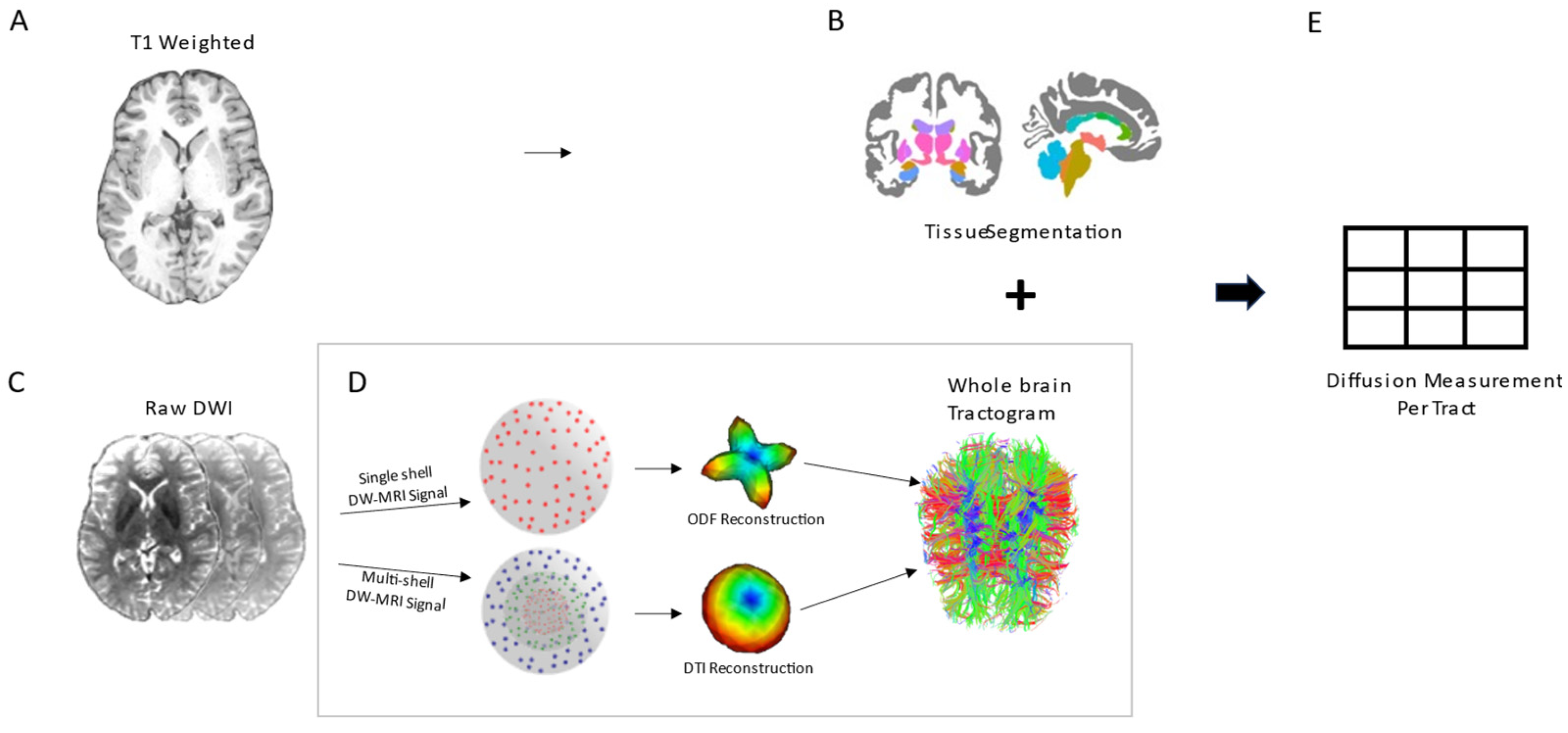
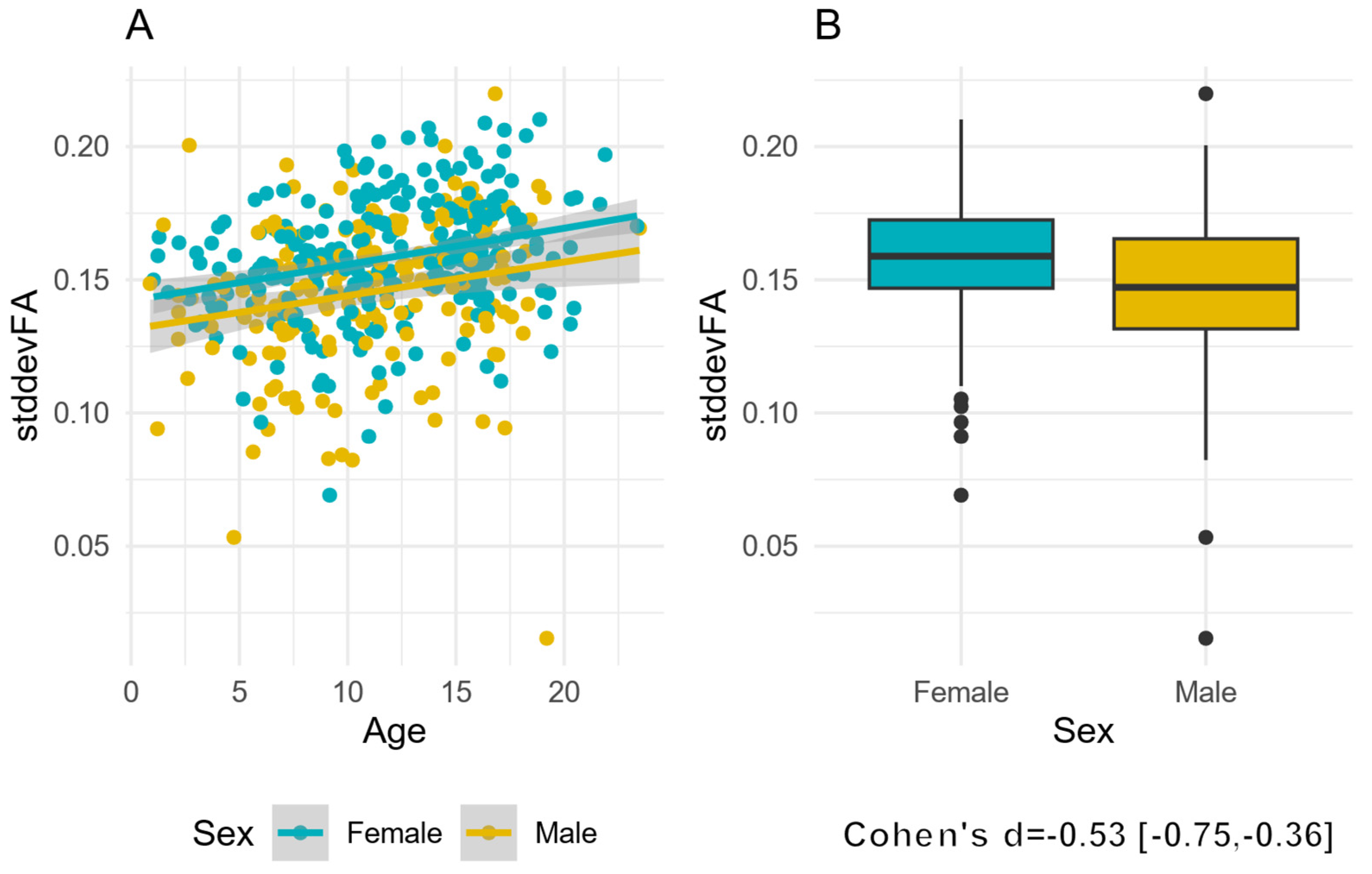
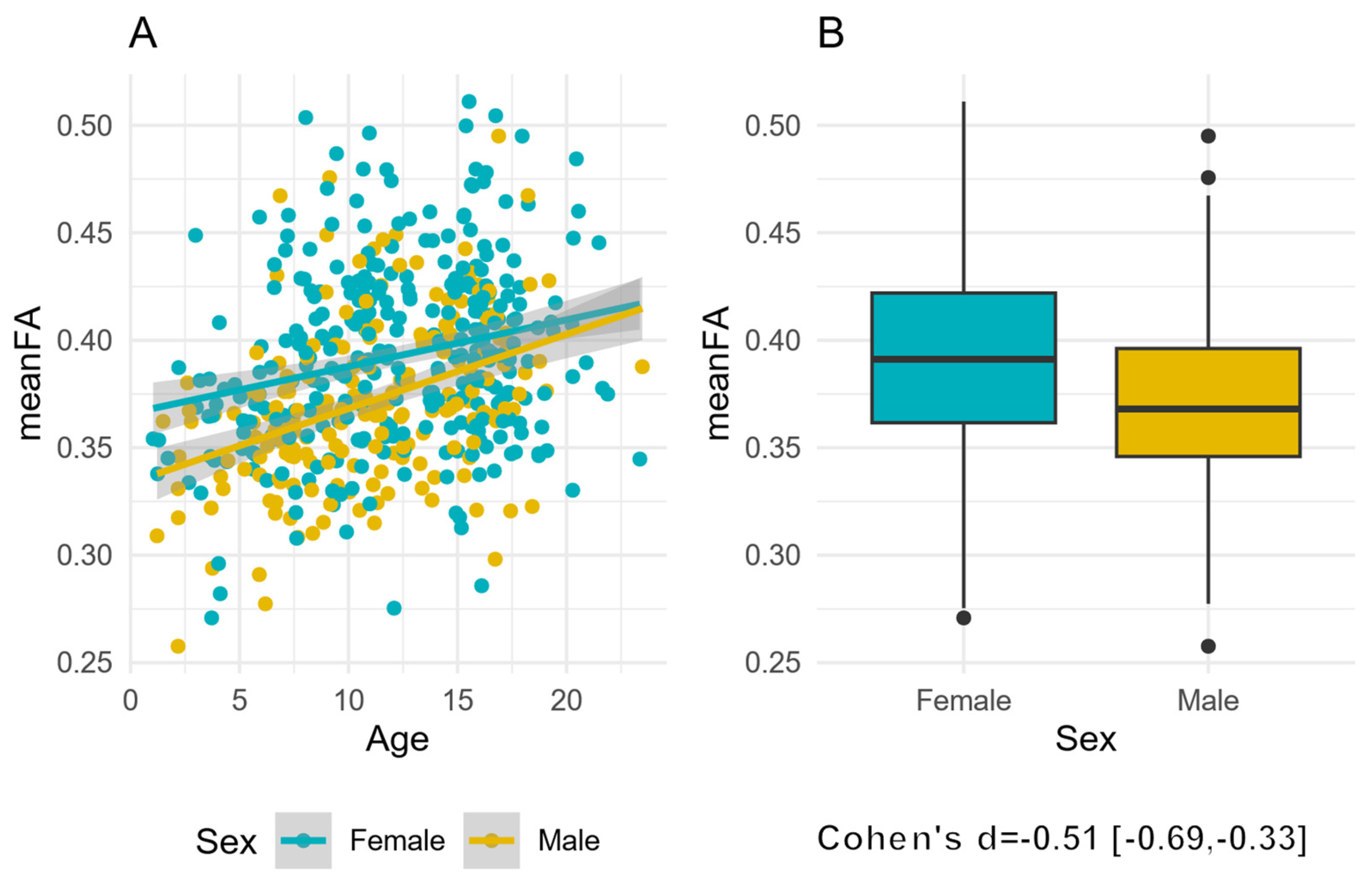
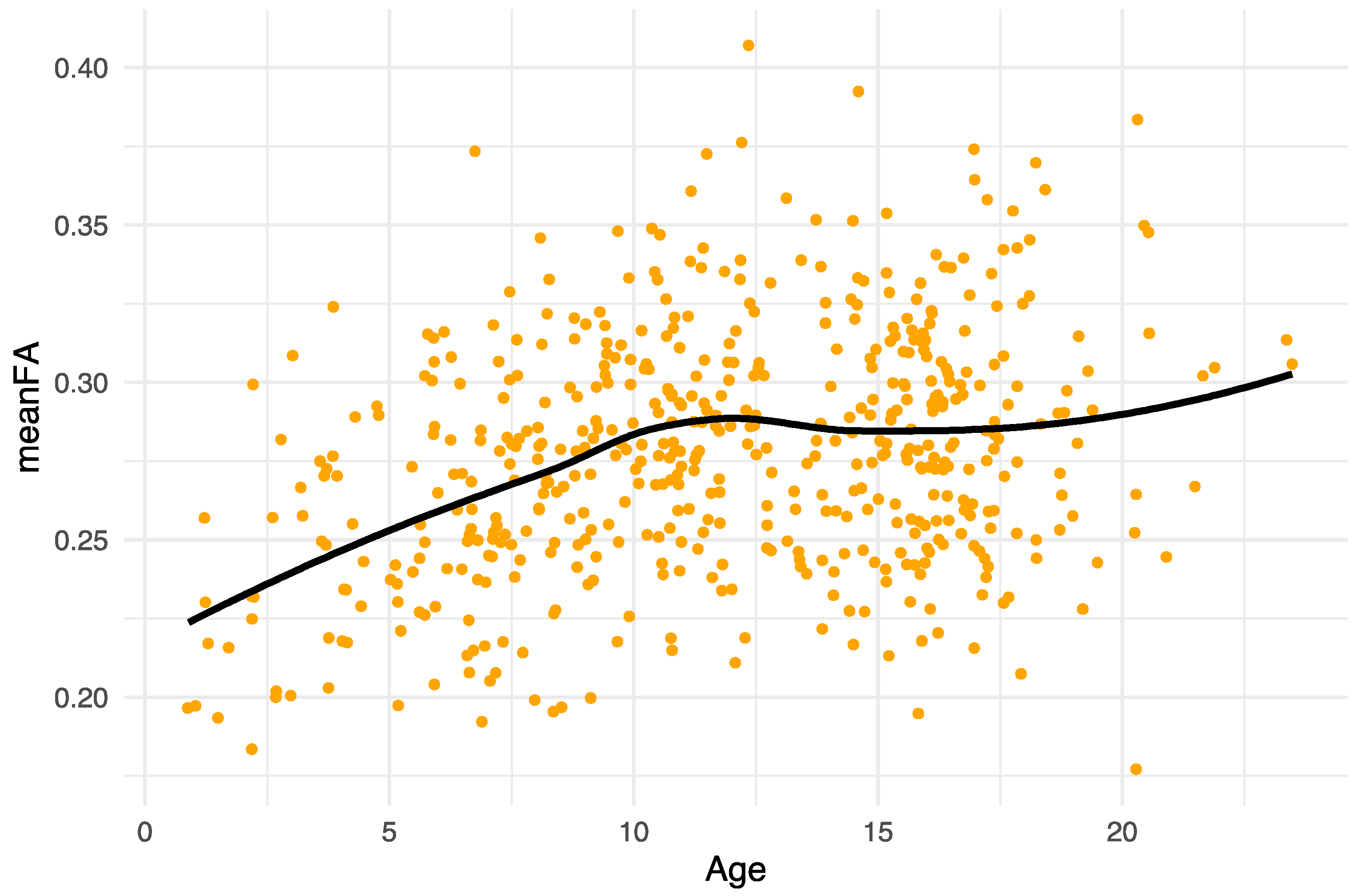

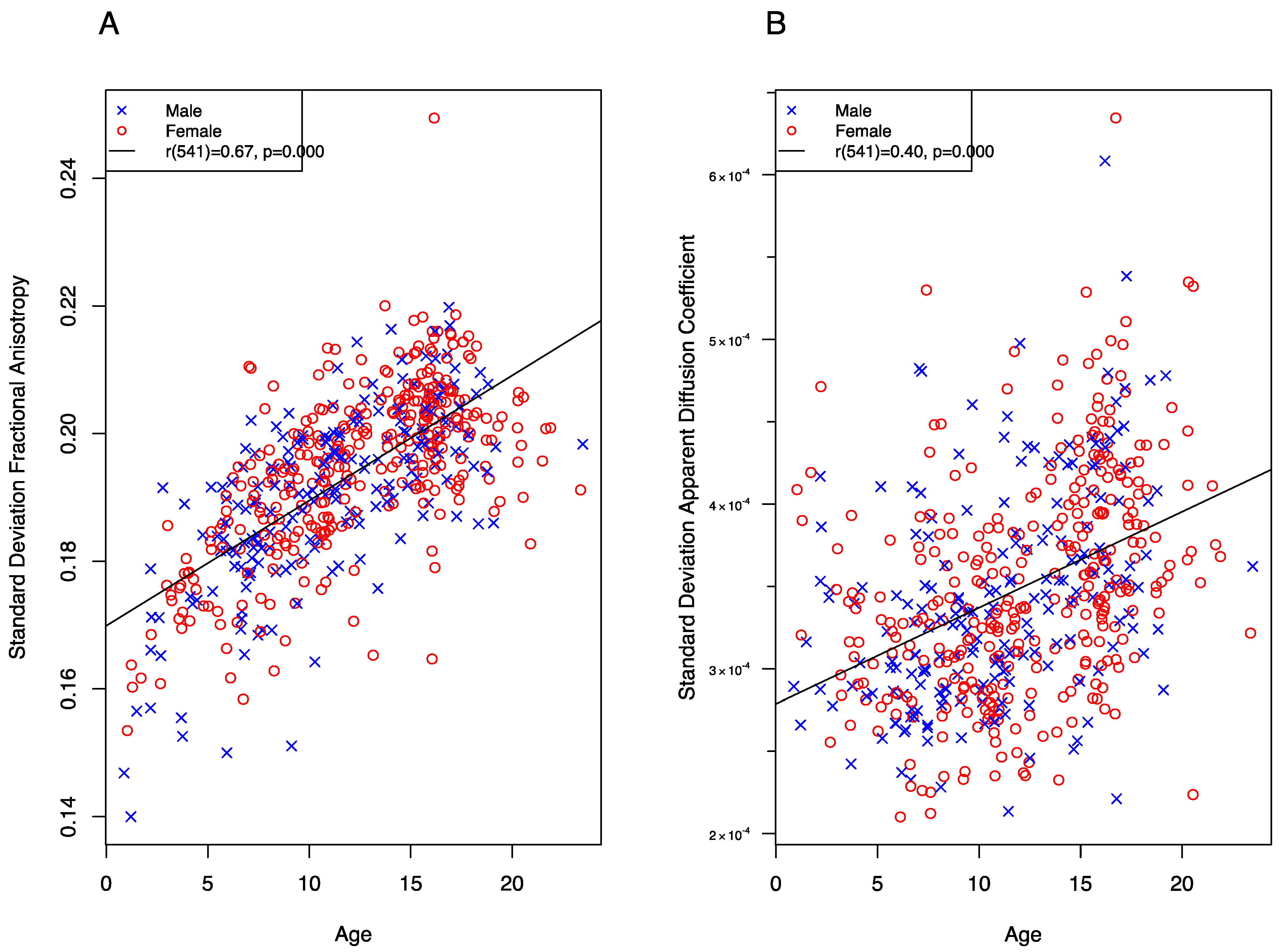
| None (<0.2) | Small (0.2–0.5) | Medium (0.5–0.8) | Large (>0.8) | |
|---|---|---|---|---|
| Average ADC | 79.90% | 20.10% | 0.00% | 0.00% |
| Average ADC asymmetry | 97.30% | 2.70% | 0.00% | 0.00% |
| Average FA | 84.50% | 15.50% | 0.00% | 0.00% |
| Average FA asymmetry | 97.20% | 2.80% | 0.00% | 0.00% |
| Number of tracts | 100.00% | 0.00% | 0.00% | 0.00% |
| Number of tracts asymmetry | 100.00% | 0.00% | 0.00% | 0.00% |
| Standard deviation ADC | 92.30% | 7.70% | 0.00% | 0.00% |
| Standard deviation ADC asymmetry | 97.20% | 2.80% | 0.00% | 0.00% |
| Standard deviation FA | 68.70% | 31.30% | 0.00% | 0.00% |
| Standard deviation FA asymmetry | 96.20% | 3.80% | 0.00% | 0.00% |
| Tracts to render | 91.60% | 8.20% | 0.10% | 0.00% |
| Tracts to render asymmetry | 97.20% | 2.80% | 0.00% | 0.00% |
| Tract | Male/Female Effect Size |
|---|---|
| Leading Average FA | |
| L medial orbitofrontal WM ↔ L middle temporal WM | −0.510 |
| L medial orbitofrontal cortex ↔ L middle temporal WM | −0.489 |
| L rostral middle frontal cortex ↔ L middle temporal WM | −0.397 |
| L medial orbitofrontal cortex ↔ L insular WM | −0.380 |
| Leading Average ADC | |
| L insular cortex ↔ L lateral occipital WM | 0.419 |
| L medial orbitofrontal cortex ↔ L insular cortex | 0.414 |
| L posterior cingulate cortex ↔ L rostral anterior cingulate WM | 0.410 |
| L lateral occipital WM ↔ L superior temporal WM | 0.409 |
| Leading Tracts to Render | |
| L superior frontal cortex ↔ L superior frontal WM | 0.673 |
| R fusiform cortex ↔ R fusiform WM | 0.645 |
| L precuneus cortex ↔ L precuneus WM | 0.625 |
| L superior temporal cortex ↔ L superior temporal WM | 0.624 |
| Leading STD ADC | |
| L transverse temporal cortex ↔ L insular cortex | −0.411 |
| L transverse temporal cortex ↔ L insular WM | −0.388 |
| R pars orbitalis cortex ↔ R pars triangularis cortex | −0.378 |
| R pars triangularis cortex ↔ R rostral middle frontal cortex | −0.369 |
| Leading STD FA | |
| L pallidum ↔ L insular cortex | −0.534 |
| R rostral middle frontal cortex ↔ L lateral orbitofrontal WM | −0.470 |
| R inferior parietal white matter ↔ R lateral occipital WM | −0.455 |
| L caudate ↔ L insular WM | −0.436 |
| ROI Start | Measure | r | p | df |
|---|---|---|---|---|
| Brain stem ↔ L insular WM | Avg FA | 0.67 | 0.00 | 533 |
| L precentral cortex ↔ L precentral WM | SD FA | 0.67 | 0.00 | 535 |
| R precentral cortex ↔ R precentral WM | SD FA | 0.66 | 0.00 | 541 |
| Brain stem ↔ L superior frontal cortex | Avg FA | 0.66 | 0.00 | 583 |
| Brain stem ↔ L superior frontal WM | Avg FA | 0.65 | 0.00 | 539 |
| Brain stem ↔ L ventral DC | Avg FA | 0.65 | 0.00 | 540 |
| L ventral DC ↔ L insular WM | Avg FA | 0.65 | 0.00 | 540 |
| Brain stem ↔ L precentral WM | Avg FA | 0.65 | 0.00 | 540 |
| L ventral DC ↔ L precentral WM | Avg FA | 0.65 | 0.00 | 540 |
| Brain stem ↔ R pallidum | Avg FA | 0.65 | 0.00 | 540 |
| L rostral middle frontal cortex ↔ L rostral middle frontal WM | SD FA | 0.65 | 0.00 | 539 |
| L thalamus proper ↔ brain stem | Avg FA | 0.65 | 0.00 | 538 |
| L postcentral cortex ↔ L post central WM | SD FA | 0.64 | 0.00 | 540 |
| R putamen ↔ R insular WM | Avg FA | 0.64 | 0.00 | 541 |
| Tract | Male/Female Effect Size |
|---|---|
| Leading Asymmetry Index (Left Divided by Right) for Average FA | |
| Caudal anterior cingulate WM ↔ rostral anterior cingulate WM | 0.306 |
| Inferior temporal WM ↔ temporal pole WM | −0.295 |
| Entorhinal cortex ↔ inferior temporal WM | −0.284 |
| Cerebellum cortex ↔ lingual WM | 0.282 |
| Leading Asymmetry Index (Left Divided by Right)—Average ADC | |
| Caudal anterior cingulate WM ↔ rostral anterior cingulate WM | 0.345 |
| Cerebellum cortex ↔ superior frontal WM | 0.316 |
| Caudal anterior cingulate WM ↔ rostral anterior cingulate WM | −0.309 |
| Cerebellum cortex ↔ superior frontal WM | −0.308 |
| Leading Asymmetry Index (Left Divided by Right)—Tracts to Render | |
| Caudate ↔ lateral orbitofrontal WM | 0.327 |
| Banks of the superior temporal sulcus ↔ superior temporal cortex | 0.323 |
| Rostral middle frontal ↔ superior parietal WM | 0.304 |
| Lateral occipital cortex ↔ middle temporal cortex | 0.297 |
| Leading Asymmetry Index (Left Divided by Right)—SD ADC | |
| Cerebellum cortex ↔ fusiform cortex | 0.340 |
| Pars opercularis cortex ↔ post-central WM | 0.325 |
| Cerebellum cortex ↔ fusiform cortex | −0.319 |
| Fusiform cortex ↔ lingual cortex | 0.307 |
| Leading Asymmetry Index (Left Divided by Right)—SD FA | |
| Inferior parietal cortex ↔ precentral WM | 1.080 |
| Precentral cortex ↔ inferior parietal WM | 0.910 |
| Inferior parietal WM ↔ precentral WM | 0.851 |
| Inferior temporal cortex ↔ banks of the superior temporal sulcus | 0.831 |
| Tract | Measure | r | p | df |
|---|---|---|---|---|
| L lateral orbitofrontal WM ↔ L superior frontal WM | Avg tract len | −0.34 | 0.00 | 155 |
| R inferior parietal WM ↔ R insula WM | Avg ADC | −0.34 | 0.00 | 152 |
| L superior frontal GM ↔ L rostral anterior cingulate WM | Avg tract len | −0.33 | 0.00 | 155 |
| R posterior cingulate WM ↔ R precentral WM | Avg tract len | −0.33 | 0.00 | 155 |
| Left parahippocampal GM ↔ R paracentral WM | Avg tract len | 0.32 | 0.00 | 155 |
| L rostral middle frontal GM ↔ L lateral orbitofrontal WM | SD ADC | 0.32 | 0.00 | 155 |
| L putamen ↔ L medial orbitofrontal WM | Avg ADC | −0.32 | 0.00 | 155 |
| L caudal middle frontal WM ↔ left medial orbitofrontal WM | SD Avg tract len | −0.32 | 0.00 | 155 |
| L putamen ↔ L unsegmented WM | Avg ADC | −0.31 | 0.00 | 155 |
| L thalamus proper ↔ posterior corpus callosum | SD ADC | 0.31 | 0.00 | 155 |
| R accumbens area ↔ L unsegmented WM | SD ADC | 0.31 | 0.00 | 155 |
| L superior frontal WM ↔ L insula WM | Avg ADC | −0.31 | 0.00 | 154 |
Disclaimer/Publisher’s Note: The statements, opinions and data contained in all publications are solely those of the individual author(s) and contributor(s) and not of MDPI and/or the editor(s). MDPI and/or the editor(s) disclaim responsibility for any injury to people or property resulting from any ideas, methods, instructions or products referred to in the content. |
© 2024 by the authors. Licensee MDPI, Basel, Switzerland. This article is an open access article distributed under the terms and conditions of the Creative Commons Attribution (CC BY) license (https://creativecommons.org/licenses/by/4.0/).
Share and Cite
Mattie, D.; Fang, Z.; Takahashi, E.; Peña Castillo, L.; Levman, J. Baseline Structural Connectomics Data of Healthy Brain Development Assessed with Multi-Modal Magnetic Resonance Imaging. Information 2024, 15, 66. https://doi.org/10.3390/info15010066
Mattie D, Fang Z, Takahashi E, Peña Castillo L, Levman J. Baseline Structural Connectomics Data of Healthy Brain Development Assessed with Multi-Modal Magnetic Resonance Imaging. Information. 2024; 15(1):66. https://doi.org/10.3390/info15010066
Chicago/Turabian StyleMattie, David, Zihang Fang, Emi Takahashi, Lourdes Peña Castillo, and Jacob Levman. 2024. "Baseline Structural Connectomics Data of Healthy Brain Development Assessed with Multi-Modal Magnetic Resonance Imaging" Information 15, no. 1: 66. https://doi.org/10.3390/info15010066





